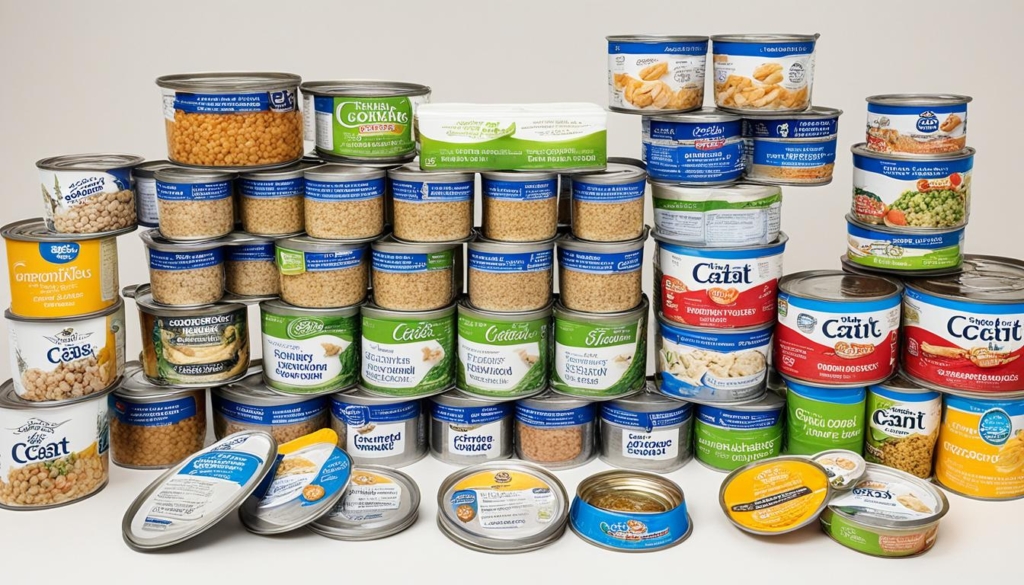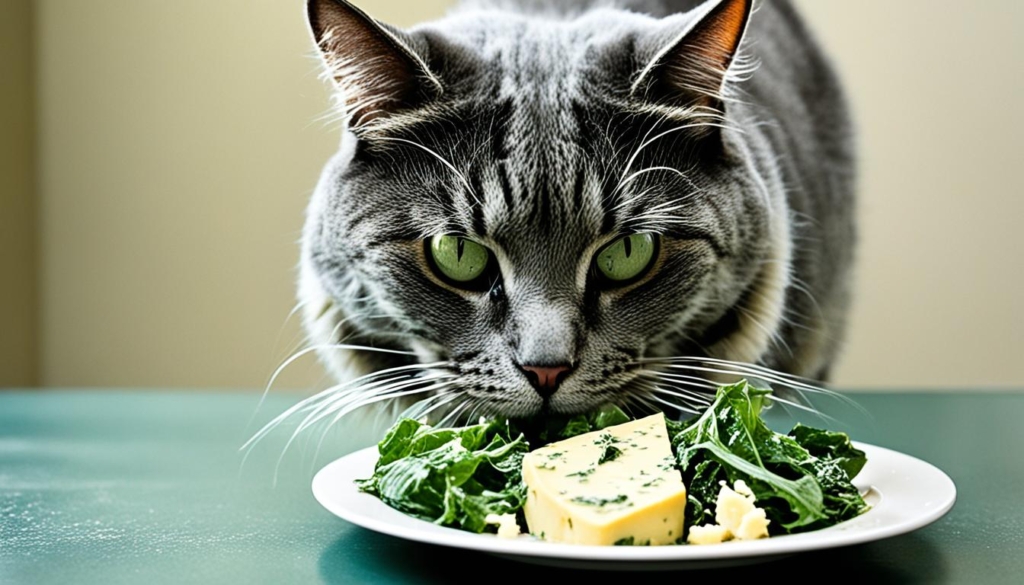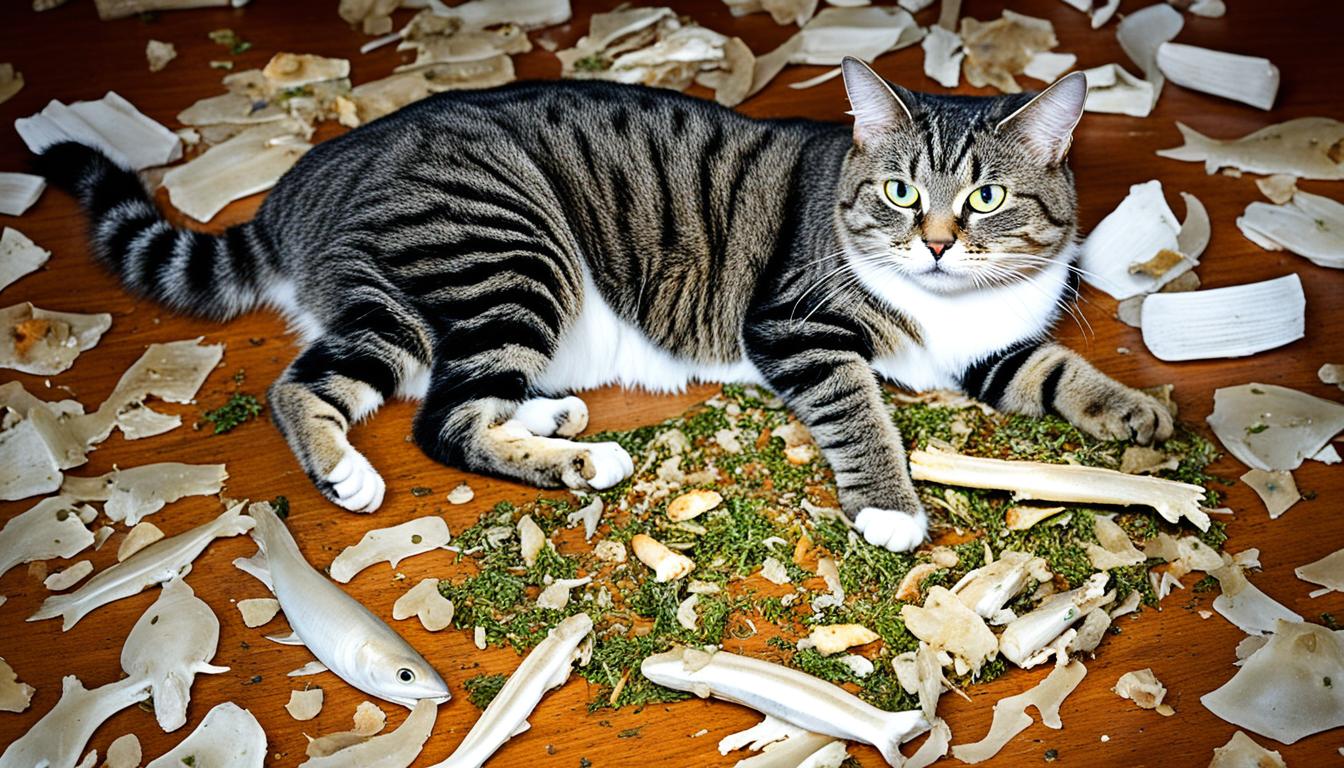Having an unexpected shortage of cat food can be a stressful situation for both pet owners and their feline friends. However, there are safe, temporary alternatives that can be used to ensure your cat gets the nutrients they need while you work to restock their regular diet. This guide will provide practical information on what human foods cats can eat when you’ve run out of their usual wet or dry cat food, as well as tips on how to transition them back to their regular meals.
Key Takeaways
- Cats can safely consume certain human foods like cooked meat, fish, eggs, and cheese in moderation as temporary substitutes for cat food.
- Grains such as brown rice, oatmeal, and barley, as well as vegetables like carrots, peas, and broccoli, can be included in a cat’s diet in small amounts.
- Fruits like bananas, berries, and melon can be offered as occasional treats, but portion control is crucial.
- It’s important to avoid feeding cats foods that are toxic or potentially harmful, such as raw meat, dairy products, onions, garlic, and chocolate.
- Maintaining hydration by providing fresh, clean water is essential when transitioning a cat’s diet.
Introduction
Cats are obligate carnivores, meaning they require certain nutrients found primarily in animal-based proteins to survive and thrive. While it’s essential to have your cat’s regular food on hand, life sometimes gets in the way, and you may find yourself unexpectedly without their usual meals. Being prepared with knowledge of safe, temporary cat food alternatives can help ensure your cat’s health and wellbeing during these times.
Transitioning to New Foods
Transitioning your cat to a new diet, even temporarily, can be a delicate process. Kittens, for example, need about twice as much food per ounce of body weight as an adult cat and should eat more often, around every 4 to 6 hours. Older cats, on the other hand, may be more set in their ways and take longer to adapt to changes in their regular cat’s diet.
It’s important to note that some cats may not transition at all, despite various methods being applied. Cats can be particularly stubborn when it comes to their food preferences, and sudden changes can be met with resistance. It’s recommended to keep notes on your cat’s preferences during the transition process to ensure a smooth and successful transition.
“Cats can go without eating for up to 36 hours; longer durations may risk hepatic lipidosis.”
Being prepared with knowledge of safe, temporary cat food alternatives can help ensure your cat’s health and wellbeing during these times. By understanding the importance of maintaining your cat’s regular diet and the potential challenges of transitioning to new foods, you can be better equipped to handle unexpected cat food shortages or disruptions.
Temporary Substitutes for Cat Food
Protein Sources
When your cat’s regular food is unavailable, you can supplement their diet with certain human foods to ensure they get the necessary nutrients. Good protein sources include cooked, unseasoned meats like chicken, turkey, beef, and lamb. Cooked, boneless white fish and eggs also provide high-quality protein. Canned tuna (without bones, oils, or seasonings) and poached or grilled salmon (also without additives) can be fed in moderation as well.
According to veterinary experts, cats are obligate carnivores, meaning that meat is essential for their survival. Taurine, an important amino acid found in commercial cat food, is necessary for cats to live and function properly. While dog food may seem like a quick fix, it does not contain all the essential nutrients that cats require to stay healthy.
| Protein Source | Benefits |
|---|---|
| Cooked Chicken, Turkey, Beef, Lamb | Natural, high-quality protein options for cats |
| Cooked Boneless White Fish | Good for cat’s eyesight, joints, and brain |
| Eggs | Protein-rich and easily digestible |
| Canned Tuna, Grilled Salmon | Provide protein and beneficial omega-3 fatty acids |
Remember, while these human food options can be used as temporary substitutes, it’s important to transition your cat back to their regular, complete and balanced cat food as soon as possible to ensure their long-term health and wellbeing.
What can I feed my cat if I ran out of food?
When you unexpectedly run out of your cat’s regular food, it’s important to know what safe and nutritious human food options you can provide as a temporary solution. Cats are obligate carnivores, meaning they require certain nutrients found primarily in meat for their health and survival. While you may be tempted to feed your feline friend people food, it’s crucial to be mindful of which human foods are safe and which should be avoided.
One of the best temporary options for cats when out of their regular food is lean, cooked protein sources like chicken, turkey, or fish. These provide the essential amino acids and taurine that cats need. Eggs, either cooked or scrambled, can also be a good source of protein. Additionally, small amounts of plain, cooked grains like brown rice, barley, or oats can be included to provide carbohydrates.
Certain fruits and vegetables can also be fed in moderation, such as bananas, blueberries, carrots, peas, and broccoli. However, it’s important to avoid onions, garlic, grapes, raisins, and other foods that can be toxic to cats. Dairy products should also be given cautiously, as many cats are lactose intolerant.
When preparing an emergency meal for your cat, it’s crucial to avoid any seasoning, sauces, or additives that could be harmful. Stick to simple, plain, and unseasoned ingredients. Also, be mindful of portion sizes, as human food can be high in calories and fat, which can upset a cat’s delicate digestive system.
Remember, while these temporary human food options can help in a pinch, they do not provide the complete and balanced nutrition that your cat’s regular commercial cat food offers. It’s essential to restock your cat’s food as soon as possible to ensure they are receiving all the essential nutrients they need for optimal health and well-being.

“When facing a shortage of cat food, it is possible to substitute regular cat food with items commonly found in the household cupboards for a one-off meal. However, this should only be a temporary solution, as human foods do not provide the balanced diet that commercial cat food offers.”
In summary, when you run out of cat food, you can provide your feline friend with small amounts of cooked protein, grains, and some fruits and vegetables as a temporary solution. But it’s crucial to restock on their regular cat food as soon as possible to ensure your cat’s nutritional needs are met.
Grains and Vegetables
When your cat’s regular cat food is unavailable, you can supplement their diet with small amounts of certain human foods. While cats are obligate carnivores and require a protein-based diet, some cat-safe grains and cat-safe vegetables can provide additional nutrients and fiber to support your feline’s temporary nutritional needs.
Grains
Cooked brown rice, barley, and oats can be incorporated into your cat’s meal in small quantities. These cat-safe grains offer a source of carbohydrates and fiber to help keep your cat feeling full and satisfied. When feeding grains, be sure to keep portions modest, as cats do not require large amounts of plant-based foods.
Vegetables
Certain cat-safe vegetables, such as carrots, peas, broccoli, and spinach, can also be added to your cat’s temporary meal plan. These should be cooked and served in moderation, as cats are primarily carnivores and do not derive the majority of their nutritional needs from plant-based human food supplements for cats.
By incorporating small amounts of cat-safe grains and cat-safe vegetables into your cat’s diet during times of limited access to their regular cat food, you can help ensure they receive a balanced and nutritious temporary meal. Remember, these ingredients should only be used as supplementary sources, with the primary focus remaining on providing adequate protein-rich options.
Fruits and Dairy
While your cat may find certain cat-safe fruits like bananas, blueberries, and watermelon (without seeds) to be an occasional treat, it’s important to remember that felines cannot taste sweet flavors the way humans do. These fruity snacks should be offered in moderation, making up no more than 10% of your cat’s daily diet.
Cat-safe dairy products, such as plain yogurt, can also be a tasty option, but many cats are lactose intolerant. It’s best to avoid milk and other high-lactose dairy items, as they can cause gastrointestinal upset. Introduce any new foods slowly and monitor your cat’s reaction to ensure they don’t experience any adverse effects.
Remember, the safest food for your feline companion is a balanced, cat-specific diet. While human food snacks for cats can be an occasional treat, they should never replace your cat’s regular, nutritious meals.
“Cats are obligate carnivores, meaning they meet their nutritional requirements by eating animal-based proteins: meat.”
It’s important to be mindful of the potential risks associated with certain human foods. Avocado flesh, which can be given in very small amounts, is quite high in fat. Additionally, the pit of peaches contains small amounts of cyanide and can pose a serious choking hazard. Always remove any pits or seeds before offering these cat-safe fruits to your furry friend.
In the end, the best approach is to consult with your veterinarian to ensure you’re providing your cat with a balanced, nutritious diet that meets their unique needs. By carefully introducing new foods and monitoring their reaction, you can safely expand your cat’s culinary horizons while prioritizing their overall health and well-being.
Foods to Avoid
While it’s understandable to want to feed your feline friend when regular cat food is scarce, certain human foods can be toxic and even life-threatening for cats. It’s crucial to steer clear of these dangerous “cat food substitutes” to protect your pet’s health.
Toxic foods for cats include raw meat, raw fish, raw eggs, cooked bones, bacon, nuts, grapes, raisins, onions, garlic, leeks, chocolate, caffeine, and the artificial sweetener xylitol. Even small amounts of these items can cause serious issues, from stomach upset to organ failure.
- Raw meat and fish can harbor harmful bacteria like Salmonella and E. coli, which can make cats sick.
- Cooked bones can splinter and puncture a cat’s digestive tract.
- Onions, garlic, and leeks can damage red blood cells and lead to anemia.
- Chocolate and caffeine contain stimulants that are toxic to cats.
- Xylitol, a common sugar substitute, can rapidly reduce a cat’s blood sugar and lead to liver damage.
Feeding your cat “people food” may seem harmless, but the risks simply aren’t worth it. Stick to your veterinarian’s recommendations for safe, nutritious feline-friendly substitutes during a cat food shortage.

“Cats are obligate carnivores, meaning they require specific nutrients found only in animal-based proteins. Feeding them a diet of human foods can lead to severe nutritional deficiencies and health problems.”
The bottom line? Avoid these toxic foods for cats, human foods cats should not eat, and dangerous cat food substitutes at all costs. Your feline’s wellbeing depends on it.
Hydration
Maintaining proper cat hydration is crucial, regardless of what you feed your feline friend during an emergency. Cats can become dehydrated quickly, and water is essential for their overall health and well-being. Ensure your cat has access to clean, fresh water at all times and monitor their water intake to keep them well-hydrated.
Importance of Fresh Water
Cats typically require about 4 ounces (half a cup) of water per 5 pounds of body weight per day. This can vary based on factors like the cat’s diet, age, and activity level. Dry kibble diets contain only around 10% water, while canned diets may be up to 70% water, which can impact a cat’s water intake. Cats may also drink less water if they are affected by heat, increased physical activity, or underlying health issues like kidney disease or diabetes.
Signs of dehydration in cats include dry gums, increased skin tenting, sunken eyes, constipation, and persistent vomiting or diarrhea. Dehydration can be a serious health concern, so it’s essential to provide your cat with a clean, ample water supply and monitor their cat hydration levels.
“Cats can theoretically survive 1 to 2 weeks without food, but any period longer than 24 hours is concerning. After 2 to 7 days without food, cats are at significant risk of hepatic lipidosis, a severe liver condition. Cats can survive without water for 2 to 3 days, after 24 hours without water, cats will become dehydrated leading to stress on their organs.”
Maintaining proper cat hydration is crucial during an emergency, as dehydration can quickly lead to serious health issues. By providing clean, fresh water and monitoring your cat’s water intake, you can help ensure their well-being and support their overall health.
Transitioning Back to Regular Cat Food
When your cat has been temporarily dining on human food substitutes, it’s crucial to transition them back to their regular, nutritionally complete cat food as soon as possible. Abrupt changes in diet can cause digestive upset, so it’s best to gradually reintroduce their normal meals over the course of a few days. Pay close attention to your cat’s appetite and overall health during this transition period.
To ensure a smooth transition, follow these steps:
- Start by mixing a small amount of their regular cat food into the human food substitutes they’ve been eating. Gradually increase the ratio of cat food to human food over the next 7-10 days.
- Monitor your cat’s reaction closely. If they seem to have any digestive issues, such as vomiting or diarrhea, slow down the transition and consult your veterinarian.
- Maintain a consistent feeding schedule and portion sizes throughout the transition. Sudden changes in meal times or quantities can also upset your cat’s stomach.
- Ensure your cat is drinking enough water to stay hydrated during the dietary changes. Provide fresh, clean water at all times.
Reintroducing your cat’s regular food is crucial to avoiding dietary issues and transitioning cats to their normal diet. With patience and care, you can reintroduce your cat’s normal food without causing any unnecessary stress or discomfort.
“Gradual dietary transitions are key to maintaining your cat’s health and preventing gastrointestinal problems.”
Remember, if your cat is not eating well, especially less than 3 tablespoons of food per day, it’s crucial to contact your veterinarian immediately. They can provide guidance on the best way to transition your cat back to their regular food and ensure their nutritional needs are met.
Consulting with a Veterinarian
When it comes to your cat’s diet, it’s always best to seek professional guidance from your veterinarian. They can provide personalized advice on your cat’s specific nutritional needs, even in an emergency situation where you may need to explore alternative food sources.
Speaking with your vet about vet advice for cat food substitutes can help ensure you’re meeting your cat’s dietary requirements. They can offer insights on talking to vet about cat’s diet and getting professional guidance on cat nutrition, which can be invaluable when navigating the complexities of feline nutrition.
Your veterinarian can assess your cat’s overall health and recommend appropriate temporary food alternatives that will keep them nourished and thriving until you can return to their regular diet. They can also provide guidance on transitioning your cat back to their usual food, ensuring a smooth and stress-free process.
Frequent feeding, rather than the type of food, could potentially lead to health issues in cats. Offering all-day dry food to cats poses risks such as obesity and health complications like diabetes, arthritis, and heart issues.”
By consulting with your veterinarian, you can feel confident that you’re making the best choices for your cat’s well-being, even in an emergency situation. Their expertise and personalized recommendations can help you navigate the challenges of vet advice for cat food substitutes and ensure your feline friend receives the proper nutrition they need.
Conclusion
While running out of cat food can be a stressful experience, pet owners have a variety of safe, temporary human food substitutes they can use to ensure their feline friends get the necessary nutrients. By focusing on protein-rich options, limited grains and vegetables, and avoiding anything toxic, you can provide your cat with a balanced meal until their regular diet is restored.
However, it’s crucial to transition your cat back to their normal food as soon as possible and consult your veterinarian if you have any concerns about your cat’s health or nutrition. Maintaining a consistent, species-appropriate diet is essential for your cat’s long-term well-being and to prevent issues like obesity, diabetes, and liver disease.
Staying informed on the importance of a regular cat diet and being prepared with tips for feeding when out of food can help you navigate these situations calmly and ensure your cat’s needs are met. By being attentive to your cat’s behaviors and eating habits, you can identify any potential health concerns early and take proactive steps to keep your furry companion healthy and happy.


